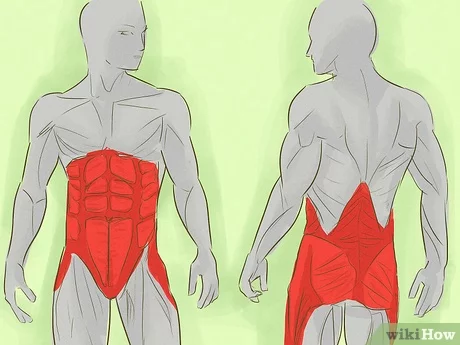
The transverse abdominal muscle is a large muscle found under the main abdominal muscles (rectus abdominis), the ones you see when you are lean and toned. Its main function is to help control the spine and breathing.
By connecting to the pelvis, ribs and anterior lumbar spine, it creates a corset-like effect, which helps control the core and support the spine. The transverse abdomen is located below your obliques, and as the name suggests, the fibers run through the body, from left to right and back again.
Since the transverse abdominal muscle is attached to the ribs and is part of the core and abdominals, it helps the forced exhalation. This is a great way to train the transverse abdominis muscle, as we'll see.
What exercises train the transverse abdominal muscle?
The challenge with transverse abdominal strengthening is that it can be difficult to know when you are actually activating this muscle. Since the transverse abdominal muscle does not contribute to spinal flexion, like the other abdominal muscles, you will need to train a little differently.
However, the potential benefits on daily living, posture, and lifting capacity are all worth the effort. We recommend focusing on two main methods of training the transverse abdominal muscle: vacuum training and core strengthening.
Vacuum training
No, you won't need your henry vacuum cleaner for this. This exercise is great for training the activation of the transverse abdominal muscle.
1. Start by finding space in the gym, similar to where you would do situps or stretches.
2. Position yourself so that you are on all fours, with your palms directly under your shoulders, your head facing the floor, and your knees directly under your hips.
3. Begin by exhaling all the air from your lungs. As you do this, bring your navel up and in, towards your spine.
4. Once the navel is all the way down, hold that position for 10 seconds.
5. Then take a deep breath and relax your stomach.
6. Repeat for 10 repetitions, for 3 series.
While the transverse abdominal muscle is attached to the spine, it can help strengthen the lower back and reduce pain and the risk of injury.
Vacuum training can be incorporated into your current ab workout. Up to 3 times a week is a good start. You can then add more reps and sets to make it more challenging.
You should then consider switching to sitting in a chair and repeating the above progression pattern again. Once you can do this, try training with the vacuum as you stand up. Just hang on to a tall counter or wall and repeat the above steps.
Prepare your core
Now, this may sound silly, but many people who squat, deadlift, overhead, and bench press don't properly prepare their core. Many will breathe into their chest, thinning their midsection and creating a weak spot they need strength.
Try this technique: Push your finger into your belly and take a deep breath. As you breathe, try to push your stomach out. You will notice that a "tightness" occurs within at the height of the breath. In this case, hold your breath deep but squeeze your abs.
This has now created "intra-abdominal pressure," and is what helps support the spine, activating the abdominals, obliques, spinal erectors, and TVA. If you are having a hard time feeling your abs strengthened, try bending your hips forward. This will flatten your lower back into a more neutral position and activate your core and abdomen muscles more.
Performing this style of bracing while in the plank and side plank position is the best way to practice, as these static and isometric exercises exercise the best transfer on large, compound movements such as squats, deadlifts, bench press and barbell.
Doing Russian crunches and twists will build your abs, while voids and bracing will strengthen your core.
Conclusion
The transverse abdominal muscle is a large muscle in the core that stabilizes the lumbar spine and helps control forced exhalation. Creates a corset around the organs and midsection, providing intra-abdominal stiffness and pressure to support the spine during heavy, compound lifts.
It can be trained through vacuum training and proper abdominal strengthening and is best trained 2-3 times a week, as with any other muscle. Adding abdominal muscle training to your routine will not only have profound benefits on your strength, but will also help protect you from injury.
PS.
Want to get awesome abs?


























